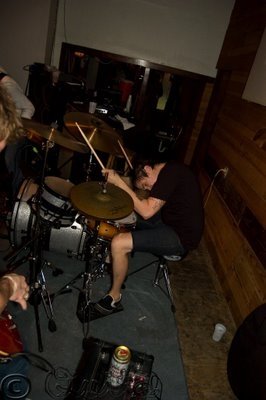A graduate of the Berklee College of Music and subsequent student of Joe Maneri’s at the no-less-esteemed New England Conservatory, Lantner’s What You Can Throw (HatOLOGY, 2007) sees the avant-garde pianist teamed again with drummer Luther Gray and Morris. On it—the Lantner/Gray/Morris trios third together—Lantner and co. perform the works of Anthony Braxton and Ornette Coleman as well as their own tunes, primarily at the suggestion of Hathut founder Werner Uehlinger. “[He] expressed an interest in hearing me play some compositions from musicians I admire,” Lantner says. “I’m really glad that he suggested it, because it got me to do something I wouldn’t have otherwise done.”
This piece is titled An Introduction because Lantner’s story clearly isn’t written yet, with just five records as a bandleader under his belt. Undoubtedly there are plenty of fascinating releases to come. Lantner and I originally spoke in January of 2007, back when What You Can Throw was slated for a spring release by Hathut. With the record put on the back burner by the label so, too, was the interview. Lantner is both engaging and possessing of interesting insights.
All About Jazz: What was the recording process like for What You Can Throw? Did it differ from previous recordings in any way?
Steve Lantner: The biggest difference for this recording was that we did a few things with other peoples’ music, so we had to devote a certain amount of time on those pesky things like not screwing up the head. The most challenging in this regard was Braxton’s “Composition 23J,” just because it’s Braxton.
AAJ: Describe if you can your relationship with Joe Morris, and Joe and Mat Maneri.
SL: Joe is a very good friend, and it is largely through his encouragement that I was able to incorporate all of my musical abilities into my playing. It was my experience playing with the Maneris that, due to their very personal vision, I had to limit myself to fit their sound. Joe Morris’ attitude is, “Play it all.” It’s a much more enjoyable experience as a musician to feel like, if you can play something and you enjoy doing it, it must be valid to your artistry. It makes life that much simpler.
AAJ: With regards to Joe—the guy seems to be the man that everyone wants to work with. In the past couple years he seems to be popping up on all sorts of albums, including a handful of your own records. You’ve been working with him for years—do you take any credit in this resurgence in his popularity?
SL: Joe is one of the hardest working musicians I know, and I have the greatest respect for him. What I love about his bass playing is that it offers nothing but possibilities. He swings like mad, and is always listening and supporting. It is true that his bass recording debut was on my CD Saying So (Riti, 2002), but he’s too fun to play with for me to take any credit for the demand he may enjoy.
What I very much look forward to is a chance to play more with Joe the guitar player. People have been focusing on his recent activity as a bass player, but he has a number of things coming out soon, including the release of a four-CD set of duets with Anthony Braxton that people will definitely want to hear.
AAJ: That sounds amazing. You’ve worked with and without a drummer. You’ve also augmented your classic trio with horns. Paradise Road (Skycap, 2006), with Allan Chase, was my first introduction to your playing. That’s just a superb record. I remember I wrote you were “Like a fast talker eager to make [your] points felt just as much as heard[.] Lantner weaves his topics of conversation in, out and around the loose rhythms.”
As far as working with horns or without, do you have a preference? Do you know going into a recording session what form you want the ensemble to take and what players you want involved?
SL:Every combination of instruments changes my playing to some degree. When I play with a rhythm section, I tend to thin out the texture, so as to allow the sound of the other players to come through. Adding a horn to my trio allows me to shape the music from behind the primary focus. Playing without a rhythm section allows me to use the full range of the piano without the fear of getting in anyone’s way. The way I play in a duo with Allan Chase is very different than how I play with the trio, in that I play a lot more piano.
It usually takes me so long to organize a recording that I tend to know well in advance what instrumentation I’ll be using and what qualities I would like my music to impart. I have now produced two recordings of my trio with Joe Morris and Luther Gray, as well as two with the quartet that includes Allan Chase. While I am happy with all of this work, there is always something I’d like to improve. It is a constant effort to get closer to an unattainable ideal.
To read more, click here or visit AllAboutJazz.com
No comments:
Post a Comment